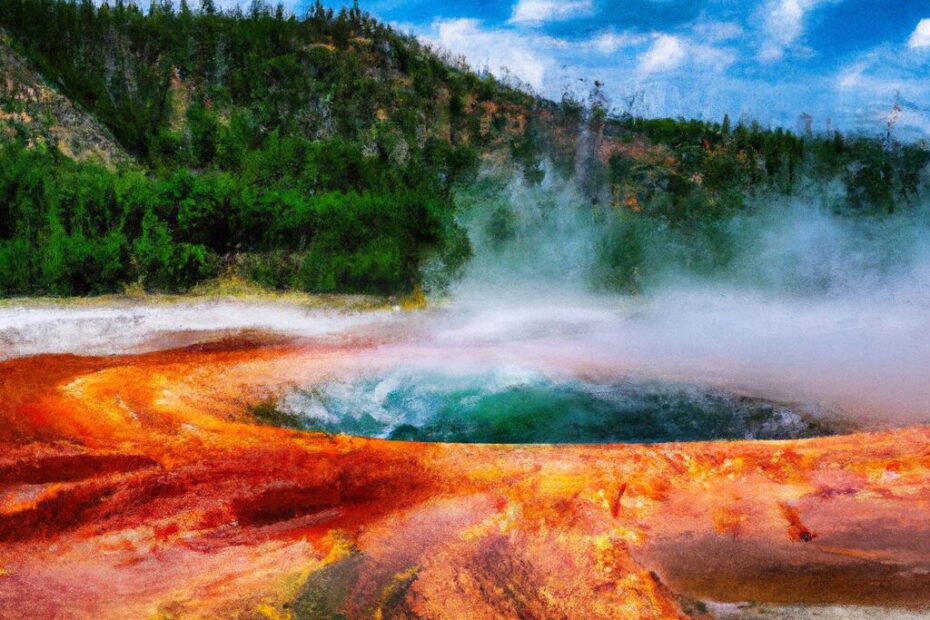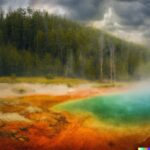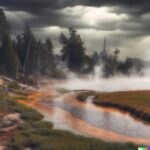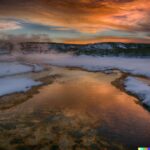Welcome to our comprehensive guide on geysers in Yellowstone National Park! In this article, we will explore the fascinating world of geysers, their types, and what makes Yellowstone National Park such a unique and iconic destination for geyser enthusiasts.
From the different types of geysers found in the park to the science behind their eruptions, we’ve got you covered. We’ll also provide tips on safely observing geysers and the best times to witness these natural marvels in action.
So, let’s dive in and uncover the wonders of Yellowstone’s geysers!
What Are Geysers?
Geysers are hydrothermal features found in various locations, including Yellowstone National Park, characterized by intermittent eruptions of superheated water and steam.
Geysers are formed when underground water meets hot rocks, creating boiling temperatures and pressure that results in periodic releases of water and steam. One of the most well-known geysers is Old Faithful, famous for its predictably consistent eruptions. Geysers are often found alongside hot springs, as both are natural manifestations of the Earth’s geothermal activities.
Where Is Yellowstone National Park?
Yellowstone National Park is located primarily in the U.S. state of Wyoming. It is known for its expansive geothermal features, including geysers, hot springs, and volcanic landscapes.
The park sits on top of a supervolcano, creating a unique environment with over 10,000 hydrothermal features. The geysers, such as the famous Old Faithful, are fueled by underground heat, while the colorful hot springs exhibit vibrant hues due to thermophiles.
The park’s volcanic history is evident in its diverse rock formations, showcasing the turbulent geological past of the region. Yellowstone’s geological significance has made it a hub for scientific research and an awe-inspiring destination for visitors keen on witnessing the Earth’s dynamic forces at play.
What Makes Yellowstone National Park Unique?
Yellowstone National Park stands out for its exceptional concentration of geysers, driven by intense geologic processes linked to the Yellowstone hot spot. This makes it a globally recognized geological phenomenon.
This hot spot, located beneath the park, fuels the numerous geysers and hot springs that contribute to Yellowstone’s unique landscape. The geysers, including the famous Old Faithful, are a striking result of this volcanic activity, providing visitors with an awe-inspiring display of nature’s power.
The ongoing geologic processes continue to shape the park, creating a dynamic environment that showcases the Earth’s incredible forces at work. With its unparalleled density of geothermal features, Yellowstone offers a one-of-a-kind opportunity to witness the planet’s geological wonders.
What Are The Types Of Geysers In Yellowstone National Park?
Yellowstone National Park hosts various types of geysers, including fountain geysers, cone geysers, plume geysers, erupting geysers, steamboat geysers, spasm geysers, sawmill geysers, as well as intriguing hydrothermal features like mud pots and fumaroles.
These geysers display an array of unique characteristics, such as varying silica content in their waters, differing eruption intervals, and the formation of distinct cones and vents around them.
Some geysers, like the cone geysers, have narrow vents that produce focused, towering eruptions, while others, like the plume geysers, emit continuous, billowing columns of water and steam.
The diversity of geothermal features in Yellowstone provides a fascinating glimpse into the complex and dynamic processes at work beneath the Earth’s surface.
Fountain Geysers
Fountain geysers in Yellowstone National Park are known for their spectacular eruptions, propelling hot water and steam into the air, creating mesmerizing thermal pools and contributing to distinctive geologic formations that captivate tourists and visitors alike.
The rhythmic and powerful displays of geysers offer a sensory experience unlike any other. As the water gracefully arcs through the air, it creates a natural symphony that mesmerizes viewers.
These geysers also play a vital role in the ecosystem. They provide a habitat for unique microorganisms that thrive in the extreme thermal conditions. Their vibrant colors and striking beauty draw visitors from around the globe, making them a significant landmark within the park’s diverse landscape.
Cone Geysers
Cone geysers in Yellowstone National Park exhibit eruptions of superheated water, contributing to the formation of distinctive mineral deposits and showcasing the intricate geologic processes at work within the park’s hydrothermal system.
These geysers are notable for their unique cone-shaped formations, which develop as mineral-rich water evaporates and leaves behind deposits of silica and other minerals.
The presence of superheated water in these geysers creates the perfect conditions for mineral deposition, leading to the stunning visual display of bright and colorful cone structures. The ongoing eruption and mineral deposition processes in cone geysers offer a remarkable opportunity to witness the dynamic interplay between geothermal activity and the Earth’s geological processes.
Plume Geysers
Plume geysers in Yellowstone National Park showcase remarkable geologic formations and contribute to the diverse array of captivating geothermal features. These unique geysers play a significant role in shaping the geological landscape of the park by their consistent ejection of hot water and steam.
The mineral deposits left behind by the eruption of plume geysers create stunning terraces and colorful pools, adding to the park’s natural beauty. Their heat exchange processes help in regulating the temperature of the surrounding hydrothermal features, influencing the overall balance of the geothermal system.
Erupting Geysers
Erupting geysers in Yellowstone National Park exhibit the powerful release of subterranean water, providing insights into the underlying geologic processes and contributing to the park’s diverse geothermal features.
These natural wonders showcase the intense forces at work beneath the Earth’s surface, as superheated water and steam erupt into the air with breathtaking force and velocity, creating magnificent spectacles for visitors.
The continuous flow of subterranean water also plays a crucial role in shaping the unique landscapes of the park, sculpting colorful mineral deposits and intricate terraces that add to the park’s distinct geothermal allure.
Steamboat Geysers
Steamboat geysers in Yellowstone National Park contribute to the formation of unique geologic features and play a pivotal role in the park’s hydrothermal system. These geysers showcase diverse geothermal features that fascinate visitors.
The powerful eruptions of geysers like Steamboat propel water and steam to impressive heights, resulting in the deposition of minerals. This process forms intricate terraces and colorful pools around the geyser, creating a constantly changing landscape in the park.
The scalding water from Steamboat also sustains a network of geothermal features, influencing the chemistry and temperature of nearby hot springs and mud pots. This adds to the overall geological significance of the area, making it a unique and constantly evolving natural wonder.
Spasm Geysers
Spasm geysers in Yellowstone National Park are influenced by a consistent heat source, contributing to ongoing geologic processes and adding to the park’s diverse thermal features and hydrothermal system.
This dependence on a reliable heat source sets spasm geysers apart from other geothermal features in the park. It allows them to maintain their unique eruptive patterns and sustained thermal activity.
The constant influx of heat fuels the underground water reservoirs, which in turn drive the geysers’ intermittent eruptions. This makes them integral components of Yellowstone’s dynamic hydrothermal system. Their distinctive attributes play a pivotal role in shaping the park’s captivating landscape, showcasing the powerful forces at work beneath the Earth’s surface.
Sawmill Geysers
Sawmill geysers in Yellowstone National Park showcase distinct vents and contribute to the formation of mineral deposits, offering insights into the underlying geologic processes and the intricate features within the park.
These geysers are characterized by their unique vents, which release powerful bursts of steam and water.
The mineral-rich waters of sawmill geysers play a significant role in the deposition of colorful mineral formations, creating visually stunning landscapes within the park.
The activity of sawmill geysers provides valuable clues about the dynamic geological processes that shape Yellowstone’s diverse terrain, making them significant features for both scientific study and visitor experience.
Mud Pots and Fumaroles
Mud pots and fumaroles in Yellowstone National Park showcase the presence of boiling water and highlight the diverse geothermal activity and geologic processes that shape the park’s distinct hydrothermal system.
Yellowstone National Park boasts unique geothermal features that are a result of the park’s underlying volcanic activity. Here, hot magma heats groundwater, creating bubbling mud pots and steam-emitting fumaroles. These hydrothermal wonders offer a fascinating glimpse into the powerful forces at work beneath the earth’s surface.
Their role in shaping the park’s landscape is undeniable, as the constant interactions of boiling water with surrounding rocks and minerals contribute to its ever-evolving terrain. For those interested in geology and natural wonders, Yellowstone is a must-see destination.
What Causes Geysers To Erupt?
The eruption of geysers is driven by a combination of factors, including the presence of a heat source, an adequate water supply, and a well-defined plumbing system within the hydrothermal structure.
When a heat source, such as magma or volcanic activity, warms the underground water reservoir, it generates steam pressure. As the pressure builds, it seeks a path of least resistance to escape, often through fissures and conduits in the plumbing system.
Simultaneously, the water supply needs to be sufficient to maintain the geyser’s activity. The interplay of these elements results in the spectacular eruption that we observe above ground.
Heat Source
The presence of a sustained heat source within the earth’s crust contributes to the allure of geysers as captivating natural attractions. This process enables the superheating of subsurface water, fueling the park’s diverse geothermal features.
This natural process involves the circulation of water deep within the earth’s crust. As it encounters intense heat, the water reaches superheated temperatures.
When this superheated water finds a pathway to the surface, it erupts in a dramatic display, creating the iconic geyser eruptions that draw visitors from around the world.
The continuous interaction of heat sources and water beneath the surface shapes and maintains the park’s geothermal features. This makes it a dynamic and ever-changing landscape.
Water Supply
An ample water supply, facilitated by heat exchange processes and mineral deposits, is crucial for sustaining the eruption cycle of geysers and maintaining the equilibrium of the park’s hydrothermal system.
Without a steady flow of water, geysers would not be able to spout their magnificent jets of steam and hot water. The heat exchange processes within the Earth’s crust create the necessary conditions for water to reach high temperatures and pressure, eventually leading to the explosive eruptions.
Mineral deposits play a significant role in shaping the structure of geysers and influencing their behavior. These deposits can act as natural obstacles and channels, directing the flow of water and modulating the eruption patterns. The interplay between water supply, heat exchange, and mineral deposits is fundamental to the dynamic nature of geysers and the park’s hydrothermal system.
Plumbing System
A well-defined plumbing system, influenced by geologic processes, plays a pivotal role in establishing the eruption intervals and sustaining the thermal features inherent in the dynamic geyser ecosystem of Yellowstone National Park.
This intricate network of underground conduits, channels, and reservoirs directs the flow of superheated water and steam beneath the earth’s surface, ultimately determining the frequency and intensity of geyser eruptions.
The interplay between the plumbing system and the subterranean geological structures orchestrates the mesmerizing displays of natural thermal activity that captivate visitors from around the world.
Periodic maintenance of the plumbing system is essential to preserve the ecological balance and protect the fragile equilibrium of these remarkable hydrothermal features.
Pressure Changes
Fluctuations in pressure, driven by underlying geologic processes, lead to dynamic changes in the eruption patterns of geysers, shaping the distinct thermal features and the broader hydrothermal system within Yellowstone National Park.
Pressure changes play a crucial role in the formation and behavior of geysers, affecting the frequency and intensity of their eruptions. This is due to the intricate interplay of hydrothermal activity beneath the Earth’s surface, which shapes the distinctive landscape of the park. By studying the influence of pressure variations on geyser behavior, we can gain valuable insights into the geological processes that have shaped Yellowstone’s extraordinary thermal features.
How To Safely Observe Geysers In Yellowstone National Park?
Observing geysers in Yellowstone National Park is a remarkable experience, and it is essential to do so safely, considering the allure of these natural wonders, the presence of scalding hot water, and the unique geologic formations surrounding the thermal features.
When visiting geysers, it’s crucial to stay on designated boardwalks and trails to avoid unintentionally stepping on delicate and dangerously thin crust. Always adhere to safety signs and instructions, maintaining a safe distance from the thermal features.
It’s important to appreciate these wonders from a safe distance to protect both visitors and the unique environment of the park.
What Are The Best Times To See Geysers In Yellowstone National Park?
The best times to witness the mesmerizing eruptions of geysers in Yellowstone National Park are often influenced by the unique eruption intervals, dynamic geologic processes, and intricate heat exchange mechanisms within the park’s hydrothermal system.
Geysers in Yellowstone National Park are not predictable, but they do follow a somewhat consistent pattern. This means that patience and observation are key when trying to witness an eruption. The geologic processes and heat exchange mechanisms within the park also play a role in the varying eruption times. By understanding these factors, visitors can fully appreciate the incredible displays of nature’s power in one of the world’s most geothermally active regions.
Frequently Asked Questions
What are the different types of geysers found in Yellowstone National Park?
There are three main types of geysers in Yellowstone National Park: cone geysers, fountain geysers, and fumaroles.
Which geyser is the most famous in Yellowstone National Park?
The most famous geyser in Yellowstone National Park is Old Faithful, which is a cone geyser that erupts regularly every 90 minutes.
What makes a geyser different from a hot spring?
A geyser is formed when underground water is heated and erupts through a vent, while a hot spring is a pool of heated water that does not erupt.
How do cone geysers in Yellowstone National Park erupt?
Cone geysers in Yellowstone National Park erupt by building up pressure from underground heated water and then releasing it through a narrow opening in the geyser cone.
Are all geysers in Yellowstone National Park active?
No, not all geysers in Yellowstone National Park are active. Some may be dormant or even extinct due to changes in the underground thermal system.
What is the best way to view geysers in Yellowstone National Park?
The best way to view geysers in Yellowstone National Park is to visit the Upper Geyser Basin, which has the highest concentration of geysers and is easily accessible by boardwalks and trails.
Last Updated on February 7, 2024 by Jon Waraas – Originally Posted: January 25, 2024

I’m Jon Waraas, and I’ve been navigating the online world since 2006. By day, I’m the proud owner of some eCommerce gems, and by night, I’m the voice behind the adventures on Waraas.Com.
My heart, however, belongs to the wild beauty of Yellowstone National Park. I’ve got a collection of websites dedicated to sharing the wonders of this natural masterpiece. Oh, and did I mention? I’m currently building my own cabin inside the ghost town of Gilmore, Idaho – a cabin with tales to tell!
When I’m not immersed in the digital realm, you’ll find me lacing up my boots for a good hike or setting up camp under the star-studded sky.




